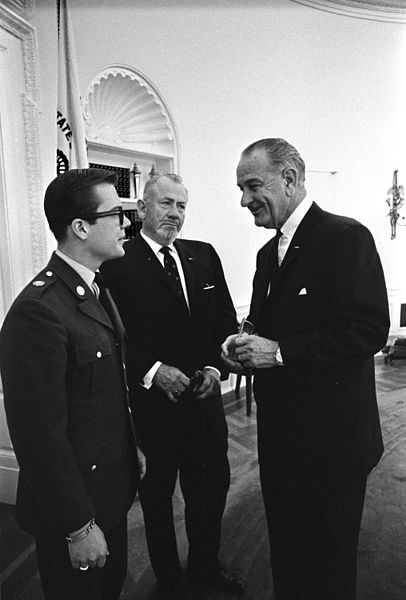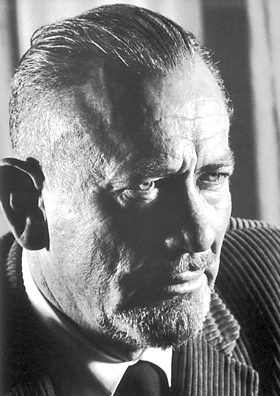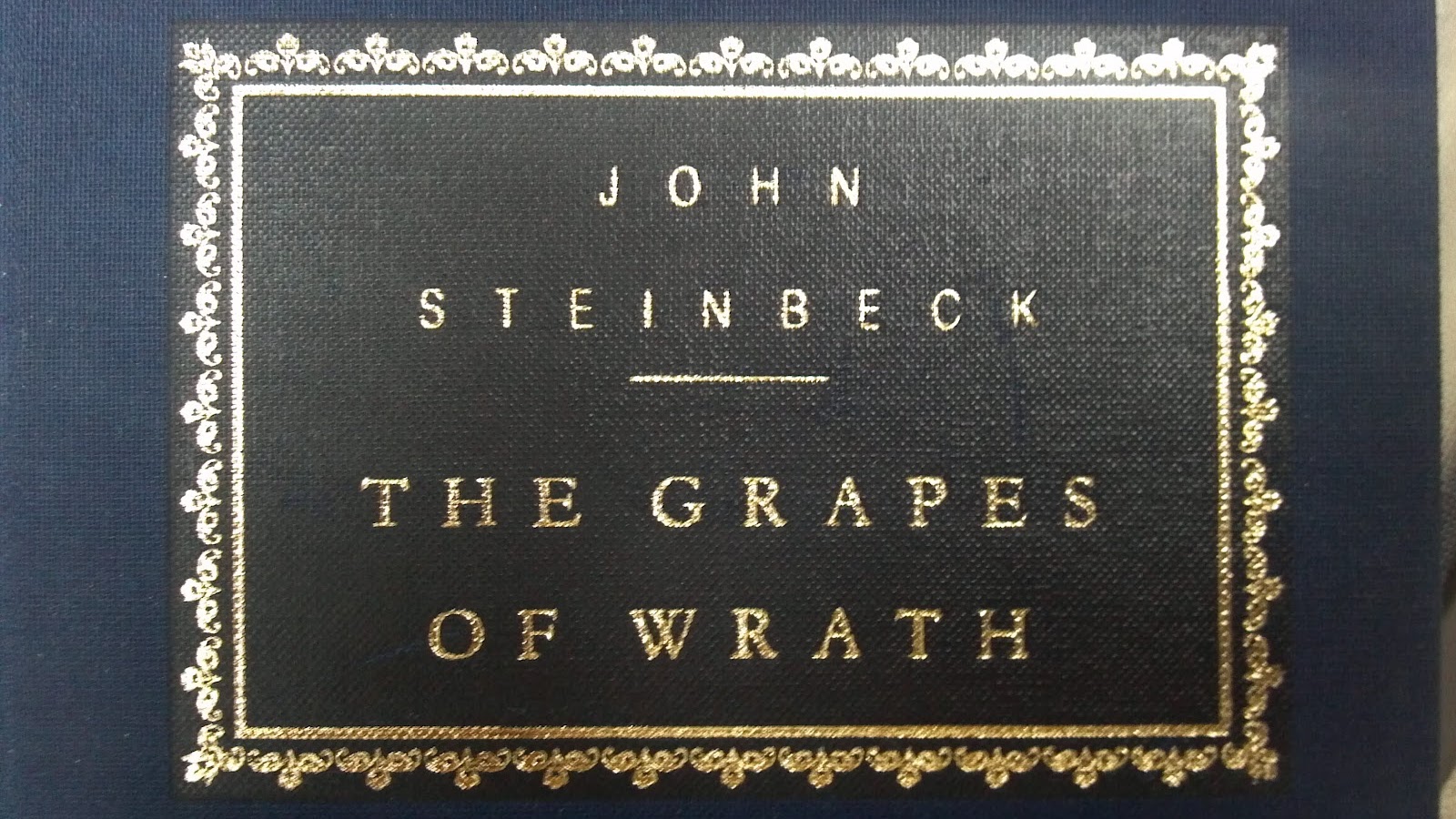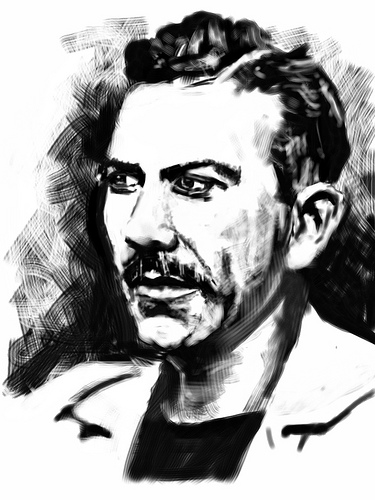Enduring Ambivalence
by David Wrobel
~
“Critics do not like to be confounded in their attempts to compartmentalize,” Simon Stow writes in his short introductory essay “The Dangerous Ambivalence of John Steinbeck,” in A Political Companion to John Steinbeck (9). Stow identifies an ambivalence about nation, government, community, and individualism that characterizes Steinbeck’s works, confounds his critics, and helps explain both their consternation and the enduring popularity of his work among readers outside of the academy. It is worth considering that Steinbeck (1902-1968), contrary to the dismissive evaluations of most literary critics, remained a force in American cultural life for three decades after what have been labeled his “years of greatness,” from 1936-1939—a remarkably productive period marked by the publication of In Dubious Battle (1936), Of Mice and Men (1937), The Long Valley (1938), and his Pulitzer Prize-winning The Grapes of Wrath (1939)1.
During the World War II years Steinbeck was subjected to federal background investigations, even as he worked to advance the nation’s cause, writing the much maligned, yet truly impactful novel and play The Moon Is Down (1942) (not explicitly, yet quite obviously about the Nazi invasion of Norway), and Bombs Away (1942) (a thoroughly positive account of a U.S. Air Force bomber team), as well as traveling to England in June 1943, and on to North Africa, Sicily, and the Italian mainland to report on the war for the New York Herald Tribune. He also wrote a pair of works set in Mexico, The Forgotten Village (1941) and The Pearl (1947), which addressed the ethical complications surrounding the intersections of modern medicine and indigenous folk cultures, and the highly successful Cannery Row (1945), which might be considered the first novel of the American counterculture.
 While less productive in the fifties, that decade did see the appearance of one of Steinbeck’s most successful and enduring novels, East of Eden (1952), which reflected the generational conflicts that came to mark the post-WWII decades, as well as Sweet Thursday (1954), the critically undervalued sequel to Cannery Row. In addition, the 1950s saw the publication of Steinbeck’s screenplay for Elia Kazan’s acclaimed film Viva Zapata! (1952), and Once There Was a War, his collected World War II dispatches (1958). Steinbeck began the sixties with what would be his last novel, The Winter of Our Discontent (1961), and with his endearing and enduring Travels with Charley (1962), an effort to come to grips with his growing sense of alienation resulting from the pace of post-war change. He was awarded the Nobel Prize for literature in late 1962, over the lamentable protestations of some American critics, and then re-affirmed his deep attachment to the nation a few years later in a collection of essays on aspects of national life and character, America and the Americans (1966). He visited Vietnam from December 1966 to May 1967, where one of his two sons was serving, and wrote a series of dispatches, supportive of LBJ’s policies and critical of anti-war protests, though he would change his position on the war before he died.
While less productive in the fifties, that decade did see the appearance of one of Steinbeck’s most successful and enduring novels, East of Eden (1952), which reflected the generational conflicts that came to mark the post-WWII decades, as well as Sweet Thursday (1954), the critically undervalued sequel to Cannery Row. In addition, the 1950s saw the publication of Steinbeck’s screenplay for Elia Kazan’s acclaimed film Viva Zapata! (1952), and Once There Was a War, his collected World War II dispatches (1958). Steinbeck began the sixties with what would be his last novel, The Winter of Our Discontent (1961), and with his endearing and enduring Travels with Charley (1962), an effort to come to grips with his growing sense of alienation resulting from the pace of post-war change. He was awarded the Nobel Prize for literature in late 1962, over the lamentable protestations of some American critics, and then re-affirmed his deep attachment to the nation a few years later in a collection of essays on aspects of national life and character, America and the Americans (1966). He visited Vietnam from December 1966 to May 1967, where one of his two sons was serving, and wrote a series of dispatches, supportive of LBJ’s policies and critical of anti-war protests, though he would change his position on the war before he died.
In short, Steinbeck’s writings serve as a remarkable guide through the controversies and complications that marked American politics and culture in the middle third of the twentieth century. If it is legitimate enough to consider the nation in middle third of the nineteenth century under the moniker Walt Whitman’s America (1995), as David Reynolds has, and to label the last third of that century Mark Twain’s America (1932), as author Bernard DeVoto did, then it seems no less reasonable to consider the years from the Depression to the Great Society through the lens of Steinbeck’s writings. Cyrus Ernesto Zirakzadeh and Simon Stow’s collection of essays, A Political Companion to John Steinbeck, is a strong addition to an excellent series of volumes (that also includes Henry Adams, Walt Whitman, Henry David Thoreau, and Ralph Waldo Emerson). The anthology moves us toward a fuller consideration of Steinbeck’s centrality to at least the first part of this mid-twentieth-century period.
Indeed, whether the tensions in Steinbeck’s four decades’ of writing are between the group man and the individual, or traditionalism and liberalism, communism and capitalism, or alienation and affirmation (from the nation), it is these very sets of seeming contradictions and their accompanying ambiguities and consequent ambivalence that characterize Steinbeck’s literary work and political thought and help account for his continuing relevance.
Not surprisingly, Steinbeck’s work in the 1930s and 1940s gets most of the contributors’ attention, including co-editor Zirakzadeh’s provocative discussion of Steinbeck as a “revolutionary conservative or a conservative revolutionary,” Donna Kornhaber’s treatment of politics and Steinbeck’s playwriting, Adrienne Akins Warfeld’s examination of Steinbeck’s Mexican works from the 1940s, Charles Williams’ insightful exploration of Steinbeck’s “group man” theory in In Dubious Battle, the volume’s standout essay by James Swensen on Dorothea Lange’s photographs and the work of the John Steinbeck Committee to Aid Agricultural Organization,” Zirakzadeh’s treatment of The Grapes of Wrath as novel, film, and inspiration for Bruce Springsteen, and Mimi R. Gladstein and James H. Meredith’s “Patriotic Ironies,” on Steinbeck’s wartime service. Other essays examine Steinbeck’s legacy in the work of Bruce Springsteen, Travels with Charley and America and Americans (together), and The Winter of Our Discontent.
 However, in addition to the absence of any extended treatment of Cannery Row, the second half of Steinbeck’s career in general gets short shrift in the volume. There is no significant coverage of East of Eden, or of Steinbeck’s powerful defense of playwright Arthur Miller in 1957 against the charges of the House Un-American Activities Committee (HUAC), or of the political backdrop of the Cold War more generally 2. Party politics are largely absent from the collection, though Steinbeck certainly had his political preferences from the 1930s through the 1960s, as evidenced in his correspondence 3. Steinbeck’s very public responses to the Vietnam War, recently gathered and republished, are also absent from the volume 4. Fuller attention to the 1950s and 1960s would have made this anthology more complete. Also absent, among the essayists themselves, are representatives of an older and still active generation of groundbreaking Steinbeck scholars, including Robert DeMott, and some leading representatives of the current generation, including Susan Shillinglaw and Kevin Hearle, whose perspectives on the politics of race and place would have augmented the volume nicely.
However, in addition to the absence of any extended treatment of Cannery Row, the second half of Steinbeck’s career in general gets short shrift in the volume. There is no significant coverage of East of Eden, or of Steinbeck’s powerful defense of playwright Arthur Miller in 1957 against the charges of the House Un-American Activities Committee (HUAC), or of the political backdrop of the Cold War more generally 2. Party politics are largely absent from the collection, though Steinbeck certainly had his political preferences from the 1930s through the 1960s, as evidenced in his correspondence 3. Steinbeck’s very public responses to the Vietnam War, recently gathered and republished, are also absent from the volume 4. Fuller attention to the 1950s and 1960s would have made this anthology more complete. Also absent, among the essayists themselves, are representatives of an older and still active generation of groundbreaking Steinbeck scholars, including Robert DeMott, and some leading representatives of the current generation, including Susan Shillinglaw and Kevin Hearle, whose perspectives on the politics of race and place would have augmented the volume nicely.
Nonetheless, for all the anthology’s voids, it does achieve the editors’ and contributors’ goal of illuminating the complexities of Steinbeck’s political thought and underscoring the enduring contributions of his work. It is a nicely edited and integrated set of explorations of the nuances and complications of Steinbeck’s political thought and a quite effective response to the generations of critics who have found Steinbeck’s work too popular, heroic, sentimental, moralistic, and too didactic. Indeed, whether the tensions in Steinbeck’s four decades’ of writing are between the group man and the individual, or traditionalism and liberalism, communism and capitalism, or alienation and affirmation (from the nation), it is these very sets of seeming contradictions and their accompanying ambiguities and consequent ambivalence that characterize Steinbeck’s literary work and political thought and help account for his continuing relevance.
 Steinbeck may not be read much in the academy, but he remains widely read outside of it. His deep and abiding dedication to the betterment of humanity and the nurturing of human relations through his art is too literally and literarily low brow for most of the arbiters of the cannon. Yet, while extremists on the right and the left attacked his work (from In Dubious Battle to The Grapes of Wrath and beyond) vehemently, a significant segment of the reading public has always felt deeply connected to it. Steinbeck conveyed, probably better than any other writer of his day, the common strivings of Americans during the Depression, War War II, and the post-war decades, and in so doing he continually sparked the appreciation of working class people and the conscience of the middle class, as well as the disdain of many members of the literary class. In placing Steinbeck’s “productive ambivalence” (9) at center stage, this companion to the intersections of Steinbeck’s literary and political journeys wisely nudges us toward a fuller appreciation of the writer and his work.
Steinbeck may not be read much in the academy, but he remains widely read outside of it. His deep and abiding dedication to the betterment of humanity and the nurturing of human relations through his art is too literally and literarily low brow for most of the arbiters of the cannon. Yet, while extremists on the right and the left attacked his work (from In Dubious Battle to The Grapes of Wrath and beyond) vehemently, a significant segment of the reading public has always felt deeply connected to it. Steinbeck conveyed, probably better than any other writer of his day, the common strivings of Americans during the Depression, War War II, and the post-war decades, and in so doing he continually sparked the appreciation of working class people and the conscience of the middle class, as well as the disdain of many members of the literary class. In placing Steinbeck’s “productive ambivalence” (9) at center stage, this companion to the intersections of Steinbeck’s literary and political journeys wisely nudges us toward a fuller appreciation of the writer and his work.
endnotes:
1. See Tetsumaro Hayashi, ed., John Steinbeck: The Years of Greatness, 1936-1939 (Tuscaloosa: University of Alabama Press, 1993).
Back to essay
2. See Esquire magazine, June 1957
Back to essay
3. See Elaine Steinbeck and Robert Wallsten’s collection John Steinbeck: A Life in Letters, (Viking, 1975; Penguin, 1989) and Jackson Benson’s finely detailed biography, John Steinbeck, Writer (New York: Penguin, 1990, and Viking, 1984).
Back to essay
4. Thomas E. Barden, ed., Steinbeck in Vietnam: Dispatches from the War (Charlottesville: University of Virginia Press, 2012).
Back to the essay
cover art by Kieran Guckian
__________
 David Wrobel holds the Merrick Chair in Western American History at the University of Oklahoma. His most recent book is Global West, American Frontier: Travel, Empire and Exceptionalism, from Manifest Destiny to the Great Depression (Albuquerque: University of New Mexico Press, 2013). He is currently working on two book projects: “The West and America: A Regional History, 1900-2000,” for the Cambridge Essential Histories series, and “John Steinbeck’s America: A Cultural History of the Nation, 1930-1968.”
David Wrobel holds the Merrick Chair in Western American History at the University of Oklahoma. His most recent book is Global West, American Frontier: Travel, Empire and Exceptionalism, from Manifest Destiny to the Great Depression (Albuquerque: University of New Mexico Press, 2013). He is currently working on two book projects: “The West and America: A Regional History, 1900-2000,” for the Cambridge Essential Histories series, and “John Steinbeck’s America: A Cultural History of the Nation, 1930-1968.”

Leave a Reply